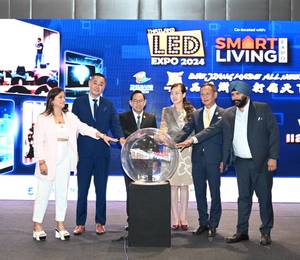How do you make the entire room is filled with bright, comfortably glare-free light with no lamp in sight? The answer is the high-performance lens LFO which is a hidden component of ceiling spotlights.
The lens combines patented lighting technology, high-quality materials and expertise in optical injection molding applications. This total internal reflection lens system (TIR) is the result of the combined expertise of two companies from Austria – the lighting design office Bartenbach and the technology service provider kdg Opticomp: Bartenbach developed the lighting technology and kdg Opticomp produced the lens. Depending on the application purpose, the lens is made either of PLEXIGLAS® (PMMA) or of PLEXIMID® molding compounds from Röhm. PMMI stands for the thermoplastic polymethyl methacrylimide.
Visual comfort through glare elimination
The lens LFO is designed and calculated in such a way that the light is focused inside the blind and spreads nearly glare-free through the room below. This creates an almost natural light atmosphere. “To achieve this, the light emitted by an LED is collimated by a second lens,” is how Christian Anselm, Director Development at Bartenbach, describes the technology. “The lens LFO ensures visual comfort by eliminating glare.” In addition, the “tunable white” function makes it possible to transition seamlessly between warm and cool lighting.
Bartenbach’s patented ceiling spotlight technology enables the lens LFO to be installed nearly invisibly in ceiling elements. Light emission is reduced to a minimum of eight millimeters, which means the opening in the ceiling panel can be smaller than the lens itself. Smaller than the width of a finger, the openings then emit light that either spreads throughout the room or spotlights a specific area, such as a table at a restaurant, even from high ceilings – depending on the chosen angle of the light beam.
High mold surface reproduction
Along with the light transmission, the design of the lens used is also crucial to this feat of lighting technology. “For the lens LFO, we structured the surface of the lenses using free-form surface facets in a way that makes the light appear homogeneous,” says Anselm. “To achieve this, we need a material that is able to accurately reproduce these miniaturized structures.”
The materials of choice were PLEXIGLAS® and PLEXIMID® from Röhm. “The high transparency of our brand molding compounds enables excellent light transmission, while their good flow properties give the sophisticated lenses high mold surface reproduction,” explains Dr. René Kogler, Head of Product Management for Lighting, Extrusion, Optics at Röhm. He points out the advantage of offering two branded products for lighting applications with outstanding optical properties from a single source: “Besides the optical properties, the two materials also have high UV and weather resistance. Due to its higher heat deflection temperature, PLEXIMID® is also suitable for applications with high heat development, such as headlamp lenses in automotive manufacturing or for integrated luminaires. This is confirmed by the recent classification of PLEXIMID® TT50 as an optical high-temperature material in accordance with UL 746B of up to 130°C.”
“Dematerialized light source”
The unobtrusive installation of the downlights is very appealing for light design in rooms with a strong architectural impact, as the lighting does not detract from the architecture. “The quality of the light may be a topic of conversation, but not the luminaire itself,” emphasizes Anselm. The lens LFO therefore embodies a guiding principle of company founder Professor Christian Bartenbach, who is internationally renowned as the “pioneer of lighting planning”: “The light source should be dematerialized so it is no longer noticeable.”
Bartenbach GmbH has continuously developed lens LFO, while the tools are constantly being adapted to the latest LED technologies. There is now also a generation of this lens that is compatible with CSP LEDs, which the company offers its customers in tailored lighting concepts. The applications range from acoustic ceilings to hotel foyers, offices, living spaces and even cable cars.
PMMI for higher temperatures
One option for ceiling lighting in very large and high rooms is arranging lenses of the same type in clusters. However, this is more elaborate and often undesired architecturally, as too many light points would be too visible. Anselm finds it a more elegant solution to achieve the same brightness with only one light point. Yet this requires a stronger LED, which increases the thermal point load. Since the circuit board becomes very hot, the lens is exposed to high contact temperatures. This pushes the molding compounds PLEXIGLAS® 8N and 7N, which are used for the lens LFO in other applications, to their limits despite their good heat deflection.
The injection molding experts at kdg Opticomp came up with the solution. “For this application, we required a material that would allow for significantly higher temperatures while also maintaining optimum efficiency. We therefore suggested that Bartenbach should injection mold this type of lens LFO with PMMI,” explains Alexander Wörle, Head of Technology and Innovation at kdg Opticomp. “From our collaboration with Röhm, we were familiar with the special molding compound PLEXMID® TT50 as a highly efficient optical plastic with an increased heat deflection temperature.”
The challenge for kdg Opticomp lay in optimizing the manufacturing processes in a way that would allow this special molding compound to be processed using the existing injection compression mold. After all, it is still also used to manufacture the lens LFO from PMMA. Their experience in handling the material allowed the company to master this challenge with highly targeted optimization loops. Wörle emphasizes, “PLEXIMID® increases the performance spectrum of lenses enormously and opens the door for new applications. We take great pleasure in providing better light this way.”
About Röhm
With 3,500 employees and 15 production sites worldwide, Röhm is one of the world’s leading manufacturers in the methacrylate business. The medium-sized company with branches in Germany, China, the USA, Russia, and South Africa has more than 80 years of experience in methacrylate chemistry and a strong technology platform. Röhm’s best-known brands include PLEXIGLAS®, ACRYLITE®, DEGALAN® and DEGAROUTE®.















